|
Strange
: Installing BusinessObjects 4.1
On Silicon Graphics (IRIX 6.5)
I want here
to thank Philippe to have help me making such install on his Indigo2
workstation.
Without him and his knowledge, I would not have come to end from this stuff
!
|
It is known that BusinessObjects servers
products like Webintelligence are
available on some Unix platforms such as Solaris,
HP-UX or more recently Linux for the XI.
What it is less known, is that,
from the past, BusinessObjects also marketed Unix versions of its
clients products (reporter, designer,
supervisor, etc...)
In fact, old BusinessObjects 4.1 full
client release was also available on AIX,
HP-UX, Solaris 2.51 & IRIX 6.2. It is on this last operating
system we will try to install
a BusinessObjects 4.1 Unix pack.
1)
Required stuff
|
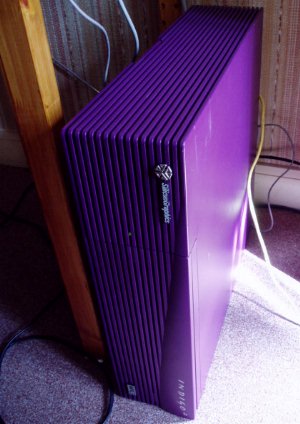 |
-
a Silicon Graphics
Indigo 2 R10000 Solid Impact workstation (Host
Name : Ekaterina)
-
195 Mhz RISC
Processor, 175 Mo of RAM, 4 Go of hard Disk....
It was in 1995 all the same!
-
IRIX 6.5 Operating System
(Silicon Graphics personal Unix System)
-
The Root
account needed to perform the install.
-
The
BusinessObjects 4.1 Unix install CD-Rom
Nota : Like any
BusinessObjects software, this one requires two serial numbers to activate,
during the setup process, the BusinessObjects modules as well as the data
sources access (Oracle, Sybase, etc...)
These serial numbers depend,
on the one hand, of the
BusinessObjects software packages (reporter, designer,
supervisor, document agent server / broadcastagent) but also of the target
platform. In fact, we first tried
without success to use some
BusinessObjects 4.1 Windows serial numbers ! |
We finaly obtained the needed BusinessObjects 4.1 Unix
special keys in an official way via the BusinessObjects
licensing service which
I would like to thank here again !
|
2) Copy the install files from the
BusinessObjects CD-ROM to the Silicon Graphics
workstation
In this case, simply
introduce the BusinessObjects 4.1 Unix CD-ROM into the drive. Then, in a
Unix Shell Window, go in the corresponding IRIX 6.2 directory of your CD-ROM
and in the Setup subfolder.
In this case, a
little more complicated, you need a DOS/Windows Personal Computer having a
CD-ROM drive and a network card, and linked to your Silicon Graphic with a
cross-cable or a hub. A file transfert software will ensures the files
transfert from the PC to a temporary directory of your Silicon Graphic (/tmp
for example)
|
You need first to configure the IP
adress of the PC and the Silicon Graphic in order they can see each other
through the network or the cross-cable. We can check it, once linked, using
the Ping command between the
two computers.
Used IP adress :
Sub-Network mask : 255.255.255.0
Once it is done, we
can transfert, using an FTP software the BusinessObjects install
directory and files from the Personal Computer CD-ROM to the Silicon Graphic
/tmp directory.
|
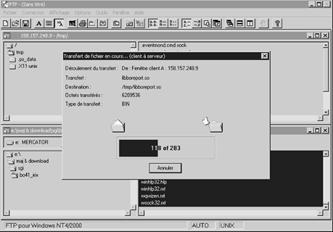 |
Nota : If you don't have a
CD-ROM drive and use the FTP transfert from a PC, you will face during setup
small case troubles.
Explanation :
DOS/Windows and Unix systems don't manage case (difference between tiny and
capital letters in filenames) in the same way. Then, the files transfered
via FTP will see their names forced in small letters when they perhaps had
on Unix one or more capital letter characters. We will explain you
later how to solve such case...
3) Lauching
setup program
Once files and
directory moved from the CD-ROM to the /tmp directory, go to /tmp using
Shell Window and enter the following commande :
# chmod
–R 777 *
This command will
avoid possible rights troubles on install directory and files giving them
all rights.
Then, lauch the Setup
program
# ./setup
A first error message
informs us the script can't manage to localise the Setup.mes
file.
# Can't
find Setup.mes
We have here the
first illustration of the previously mentioned case trouble. The
Setup.mes
file on the install CD-ROM has became
setup.mes (Without Capital S) during
the FTP transfert and the script, looking for
Setup.mes, can't find it.
Then, open another Shell Window, go to the subdirectory where the
setup.mes
is and rename it Setup.mes using the following command :
# mv
setup.mes Setup.mes
Launch again the
Setup program
# ./setup
Another error message
is diplayed, proof that if the Setup.mes file is now well found, we face
another problem...
#
Variable syntax
Using
more setup
command, we are able to display the setup file content and we see that it is
not a binary files but a text format script shell.
# more
setup
|
The setup script aims to check the
platform type (AIX, HP-UX, SunOs or IRIX)
using the UNAME system variable, and,
depending of his value, to set some variables needed
by the setup script.
Written to
IRIX release 6.2,
the UNAME
variable had IRIX value on this release while under IRIX
release 6.5, the UNAME value is now IRIX64. This is why we face this error
message.
We have now to edit
the setup script using text editor like VI...
# vi setup
|
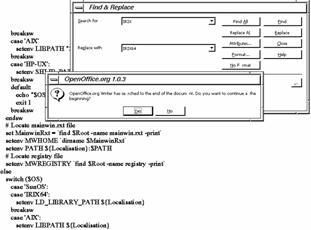 |
|
...and search and
replace all IRIX string chains by
IRIX64 (there are only 2 occurences).
Then, save the edited setup script and start it again.
# ./setup
|
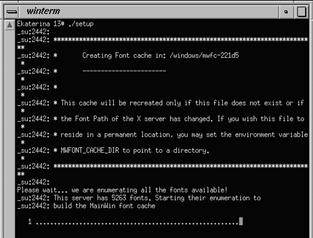
|
Once this last modification done, the setup script is
launched without any errors and it starts puting some fonts in cache. The
activity is materialized by a points progression bar... |
Once fonts put into cache, we find again
the well-know BusinessObjects setup wizard with an old Windows 3.1 look and
fell...
Click on
Begin
to start...
|
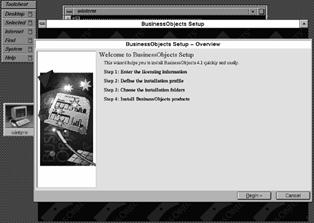
|
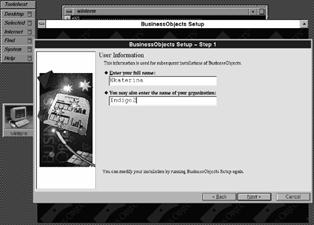
|
Let's start the setup process filling in the
users and
firms
names in the corresponfing fields.
Then click on the Next button to carry
on.
Nota :
As you have already been able to note at this step, this BusinessObjects
software release is only available in english.
|
Then, fill-in the Product and
Data Access key and click on
Next to carry on. |
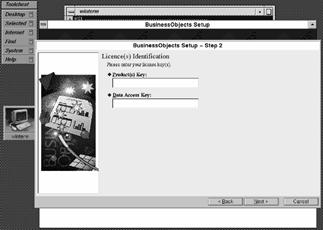
|
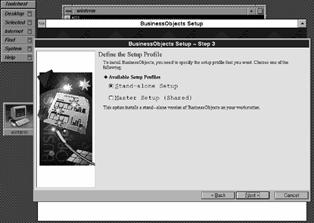
|
Choose after Stand Alone Setup then click on
Next. |
Select
Custom Setup
and
click on Next. |
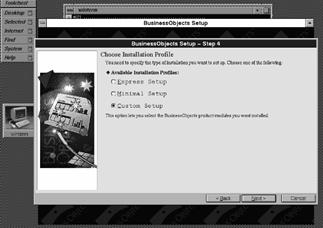
|
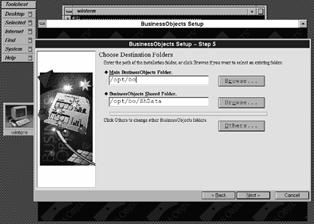 |
Enter the following paths :
Main BusinessObjects Folder :
/opt/bo
BusinessObjects Shared Folder :
/opt/bo/ShData
And click on
Next
Nota :
Because of rights troubles, the setup program should not be able to create
iself the bo directory. In this case, manualy create it yourself
using mkdir bo
command before at
the right place under /opt and launch again the setup program.
|
In the first case, if all
things go well, BusinessObjects ask you to confirm the directory creation.
Click on Yes to validate then on
Next to reach the next step. |
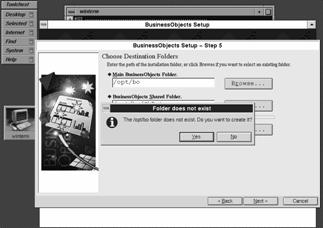
|
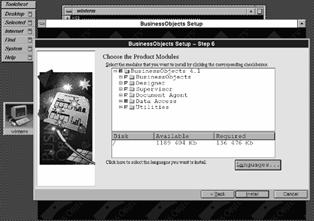 |
On this screen, BusinessObjects setup
program show you the products you will be able to install with the serial
number you entered previously. By default, all checkbox are checked.
At data access level,
the checkbox buton is grayed, which means that only few DataAcess entries
are available. In fact, the serial number provided by the BusinessObjects
licencing service only activate the Oracle Middleware
Then, click on
Install to launch the installation
Nota :
No need to select another language clicking on the corresponding button :
Only english one is available
!
|
Then, setup carry on with the file copy operation.
Nota :
If you have transfered the installation files using an FTP software, it is
now you will probably face other case troubles and file localization.
(Objects.lsi on disk1, Makefile on disk3, font afm, help files...)
At each error message, localise the file having trouble, see with which case
it is awaited, and, in another Command window, change it case via the
command:
# mv
badecase.ext
BadeCase.Ext
Don't forget, to,
each time, specify again to the setup program, the subdirectory where the
file is using the Browse button.
|
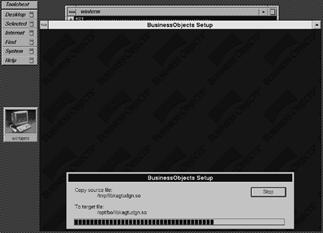 |
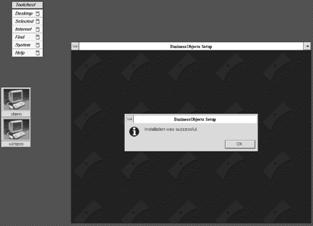
|
Click on
OK
to validate the end of the setup process. |
|
Once the setup is closed, BusinessObjects displays you the
elements which have been installed. Click on
Exit to leave the program of
installation. |
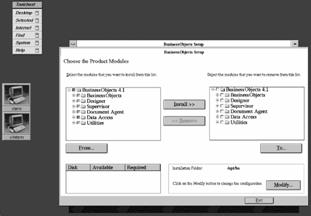
|
4)Setting-Up
BusinessObjects parameters
|
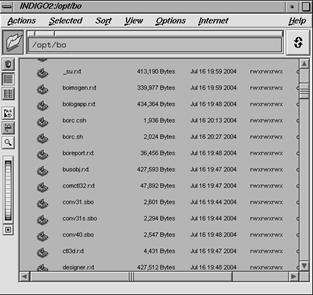
|
Before launching BusinessObjects, some
environment variables must be initialized using the files
borc.sh or
borc.csh according to the type of used shell.
Like the previous Setup script file,
borc.sh and
borc.csh are two Shell scripts usng also the UNAME
variable and value IRIX64 to identify the platform.
Then, in the same way than
previously, edit borc.sh and borc.csh using a
text editor text olike VI, and
replace all IRIX string found by IRIX64 and
save the modified scripts.
# vi
borc.sh
# vi
borc.csh |
Enter the following commands to
initialize the environment needed by BusinessObjects execution :
# setenv BOHOME /opt/bo
# source $BOHOME/borc.csh
|
5) BusinessObjects
first start
At the end, launch
BusinessObjects using command :
# ./busobj
|
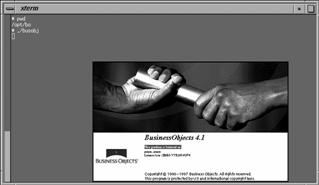
|
|
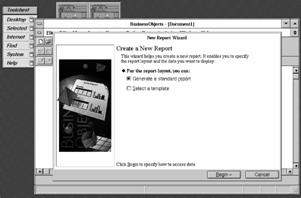
|
Now, we face the well-know BusinessObjects screen and his new report wizard. |
|
Nota :
You can change the default Windows 3.1 Look & Feel Windows 3.1
into motif
clicking in the left higher corner of the window and
choosing Change Look and
Motif.
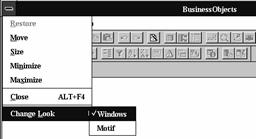 |
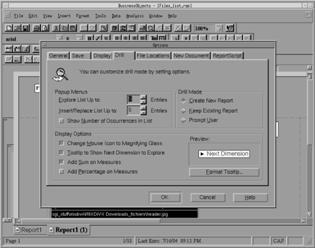
The BusinessObjects 4.1 display and
the Options
menu with the Motif Look and Feel
|
|
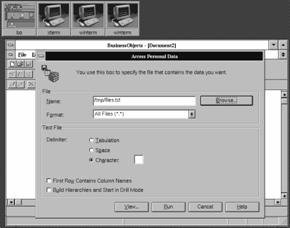
|
Warning : Because we have no Oracle Client on this Silicon
Graphic workstation, we will not be able to connect to a repository or create a
query using an Univers.
But we can stile
evaluate the product functionnalities creating a query based on a flat file. |

Note the
Windows 3.1 look & feel of the iconized
BusinessObjects windows
|
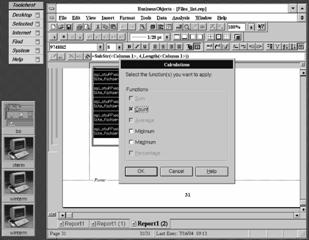
Application of the count function on a table. |
|
6)
Launching the Designer program
In the same way than
previously, launch the designer program
with the command:
# ./designer
|
|
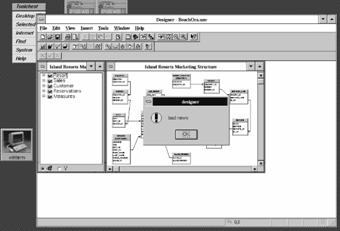
|
Strange error message under Designer when you select the
Windows/Tile command... |
|
6)
Launching the Supervisor program
In the same way than
previously, launch the Supervisor
program with the command:
# ./supervsr
|
|
Here
also, because we don't have an Oracle client software, the repository
connexion is not possible and, due to this, the program launching itself.
The
only thing which can be done is launching the Repository creation wizard
entering :
User Name : GENERAL
Password : SUPERVISOR
But it will not
succeed because of the missing Oracle client software.
|
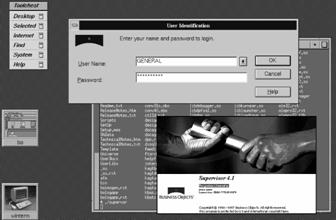 |
| |
|
 |
| |
This site is not
endorsed by of affiliated with
sap.com
Last update on
12/03/2014 |
Top of page |
|